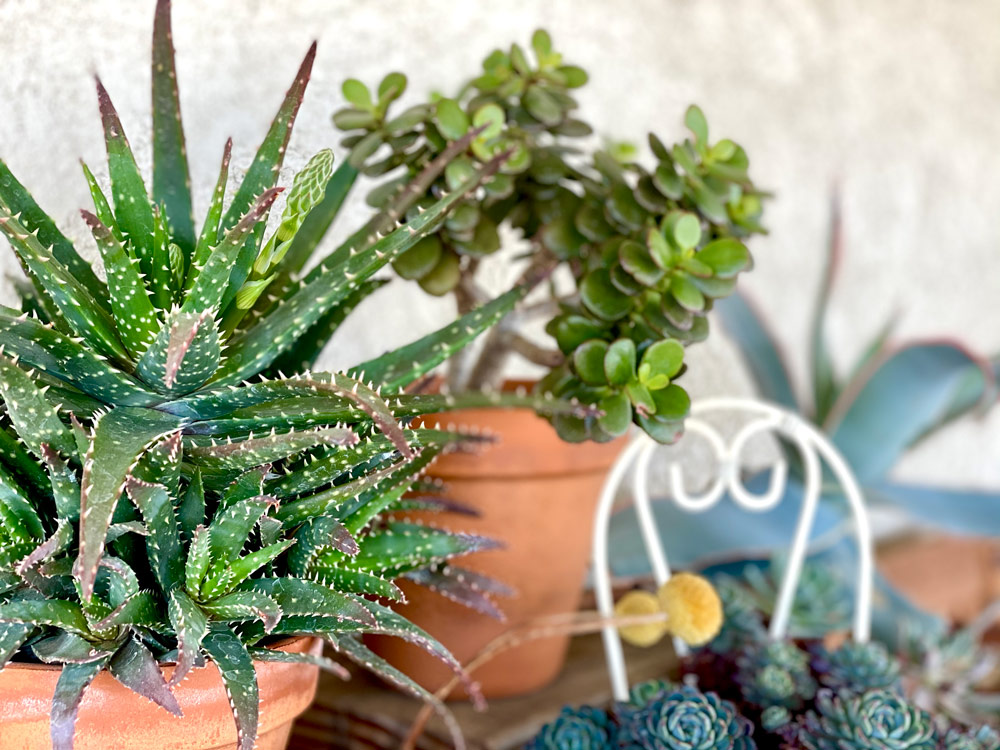 Above: Various potted aloes, agaves, and succulents on a patio table display. The aloe in the foreground has a bloom starting to sprout.
Above: Various potted aloes, agaves, and succulents on a patio table display. The aloe in the foreground has a bloom starting to sprout.
We start feeding our plants in April each year. The cold weather is mostly gone and there are more consistently warm days during this month. The warmth wakens the plants from their winter dormancy.
Once a month (and occasionally twice a month) during the growing season, I feed our potted plants. For the in-ground plants, it's a different schedule which I'll go into later on.
For a few years, we tried different plant food/fertilizers we could easily find in local stores. However, after watching one of our favorite plant people, Nigel Saunders from the YouTube channel The Bonsai Zone, we learned what kind of general plant food he gives his successful collection.
BTW, you can learn a lot from other gardeners/plant enthusiasts even if they don't fit your growing zone or even match the type of plants you grow. Once you get to know your plants, your climate, your soil, your weather extremes, and your obstacles – and you gain that knowledge through experience, failures, and successes – you can take techniques and advice from them and adapt to your own gardening. I may write a future article just on that!
Nigel uses a 20-20-20 mix that is water soluble. A 1:1:1 mix is a good general one. What does 1:1:1 mean? It represents the N-P-K ratio which is the percentage the food contains by volume of nitrogen (chemical symbol N), phosphorus (chemical symbol P), and potassium (chemical symbol K). So the 20-20-20 mix contains 20% nitrogen, 20% phosphorus, and 20% potassium. The 1:1:1 number means the ratio of the elements is even. Fertilizers come in other even ratios, like 5-5-5, but the lower the number, the more diluted it is.
So why a 20-20-20 mix? It meets plants general needs and promotes more leaf and stem growth. It also provides strength to the plant. If you're trying to promote something else on particular plants, a different ratio might be needed. For example, I have a few potted roses and while I use the 20-20-20 mix on them, they are hungry plants when they are making flowers so I will add a different mix during their flowering seasons to promote more blooms and overall healthiness.
When dealing with cacti and succulents, you will get various opinions. But we've been using our mix for a few years now with really great results! According to Planet Desert (one of my favorite online stores I've purchased a few cacti and rare plants from), "Some people say that cacti don’t need as much nitrogen or phosphorous. We haven’t found that to be true. Having tested the different types of fertilizer, the regular 1-1-1 mix works best... and we have a pretty big sample size." Be sure to check out their article for some great cactus and succulent feeding tips!
So what fertilizer do we actually use? We use a tub of Jack’s Classic All Purpose Fertilizer (20-20-20) from the company JR Peters based in Allentown, PA. This fertilizer is tried-and-trusted by professional growers. Besides it meeting the needs of many of my plants, I also like that I can use a one-for-all solution rather than a specialty fertilizer for this plant and another one for this other plant thus cutting down the amount of purchased plastic based products (say that three times fast!). It is also food safe meaning I can use it on my vegetable and fruit plants too!
Feeding In-Ground Plants
To be in-ground in our Mojave Garden, a plant must be drought-tolerant, native, or a combination of that. We don't regularly water our in-ground plants with the exception of newly planted ones. This is to conserve our precious desert water and to have a better chance of growing strong to tolerate our extreme summer heat and occasional below-freezing winters. If we do feed our in-ground plants, including larger cacti, agave, and aloes, we will give them plant food right before a monsoon rain or a steady rain. We don't do this often throughout the year, and based on how much rain we get, we might not feed them at all that year.
Native plants are a little more trickier too. We tend to let them just be. We've had some native plants grow too vigorously, which sometimes means not thick enough stems, trunks, or branches, and a windstorm, snowfall, or downpour can snap too-thin plants parts.
Feeding Schedule
As I mentioned earlier, starting in April of every year, I feed our potted cacti, succulents, aloes, agaves, mangaves, desert plants, veggies, berry bushes, and other potted plants once a month, and on occasion, twice a month during the growing season. I will stop as we get to fall as the plants are typically preparing for winter dormancy and don't need to promote new growth. In-ground plants get fed during rains, if even that.
